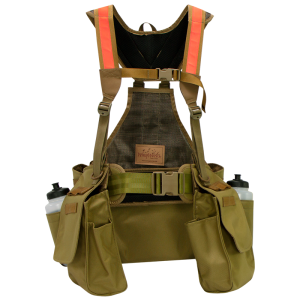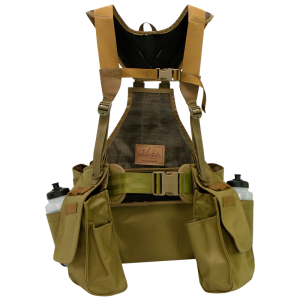Outfitting the Vests
Some Vest Set-Up Options by Component 1/25/25
Overview
When we forget something for a hunt it’s often something we took off the vest and never put back. Like having a dedicated hunting vehicle, consider leaving a lot of things in or attached to the vest so in the confusion of leaving home they aren’t forgotten or misplaced. If you need another whistle or camera, don’t remove it from the vest…just get another one.
The other side of this is overthinking what you need and overloading the vest with things you never use. One way to avoid this is to platoon things in zip lock bags to throw in or remove on particular hunts or situations.
Shellpockets
Keep in mind that the long shellpocket flaps are designed to be tucked and Velcro’d into the pockets for no-look shell grabs. Some will want both pockets for shells, but we recommend going with your strong side pocket for shells and leaving the other for quick access items that may change from hunt to hunt. If you’re training or short on water storage, the 54 oz bottles we sell will fit easily in the long shellpockets where they’re easy to access, and balance out shell weight on the other side.
New Molle bases on each flap offer lots of pouch/holster options, but if one pocket is left open for shells it means just one front Molle pouch in use at a time. So far the iPhone plus size holster and lightweight pistol holsters have been the most popular for regular use. There are a lot of others out there, but check the width of straps on pouches to make sure they’re compatible with these Molle bases. Some of the cheaper Molle pouches are not very consistent on Molle layout and snap placement, so consider sorting through them to find a good fit. Depending on the pouch strap lengths, we have 2 top strap level options to make sure the fit is snug at the top of the pouch.
For handheld electronics we replaced the old flat slash pockets on the shellpocket front sides with a larger single pouch. Garmin Alphas/Astros and most other larger handhelds will fit safely, meaning the pocket is deep like the shellpockets to prevent accidental loss. A great location if you don’t have to use them constantly. Other items that fit include certain sizes of bear repellent, 1.5 oz Ballistol Spray Lubricant or other, semi-auto pistol clips, wire cutters for snares, larger multi-tools, snacks, chukar calls, rolls of vet wrap, cameras and walkie talkies. A long slash pocket remains on the back side of each pocket for longer narrow items like hemostats, forks, bird neckers, knives, snare cutters and multi tools.
We used to offer several leather Garmin GPS holsters for shoulder location and lift/drop upside down style. There are many options out there now, we like one that belt mounts and protects the screen from accidental tics without using the screen lock every time. Do what works for you.
Regarding Molle mount pistol holsters, most hunters opt for a crossdraw mount on their offside pocket flap, leaving their strong side for shotgun shells. We offer a lighter and heavier version with similar footprints, but very different in appearance. The heavier version has a lot of adjustment for size and a stiffer base panel, and fits full frame semi-autos best. It’s only available in RH, while the lightweight holster is ambidextrous and is less obvious as a sidearm holster.
If you need a lanyard on anything going in or out of the pouches and pockets, the D ring at the base of each harness base is a good place to tie it. We also use 1/8″ coyote bungee through small grommets installed closer to or even inside a pouch to keep things hidden. Another option is to open up a seam and resew with the small bungee lanyard in the seam for things like dedicated whistles that stay on the vest.
We haven’t built in any shell loops, preferring to pull out of sort of a “speed bag” pocket. We now offer shot shell strips in 3 different gauge sizes that can velcro connect to a gun or parts of the vest. We’ll sew velcro to the offside shoulder strap for these on vest orders and can provide adhesive velcro for gun mounting. There are always options for customizing this sort of thing as we’ve done for a couple of smaller gauge shells on our Tech Sheath shoulder mount camera or phone case.
Beyond the ordinary, shell pockets can be removed and cowboy action leather shell strips can be threaded on the 2″ webbing, or replaced by large sidearm holsters or many other configurations for bug-out solutions, photography or big game hunting.
If you like to tweak other details, consider getting a used industrial sewing machine. Once you figure it out it’s like having a table saw in the garage.
Shoulder Harness
Part of wearing a “waist loading vest” properly is getting the belt at the right level, usually centered over the belly button. The harness should only hold around 25% of the vest weight, and help hold the belt in the hip load position. The new harnesses are somewhat padded with a larger surface area to spread the load. Mesh has replaced the old nylon yoke, and it’s lined with a more breathable material. There’s also a right/left element as we left just one adjustment strap end going away from the shooting shoulder.
The offside shoulder is still open for a vertical mount, removable pouch. We sell 3 on the site, mainly suited for phones or cameras. The Tech Sheath will fit most point and shoot smaller cameras and smaller phones, while the slightly larger iPhone plus size holster will fit smaller iPhones, without jumbo protective armor. The holsters can be customized to hold whistles and a couple of shells on the flaps, or other small things. It’s a great location for fast access, but keep it simple so not to get in the way of gun mount.
We sometimes sew D rings to the Hypalon patch to hang whatever, or sew 2″ Velcro to the shoulder area to stick a small electric collar handheld or walkie talkie with adhesive Velcro on the back. Most of these have a lanyard backup around the neck or to a D ring.
Gamebag
This vest is not a pack with frame or stays, so keeping the most dense load close to the body is even more important, keeping the load more vertical.
Can’t do much about birds, they go into the gamebag, which these days is built from HD mesh fabric that helps them cool down more quickly. If you’re really concerned with cooling things down to maintain meat quality, consider gutting birds and pushing green grass into the cavity, or better yet swing by the truck and drop them in a cooler. Not a bad idea to have a couple of baggies along for hard hit birds that bleed excessively to avoid a mess.
Loose water containers are heavy and tend to bounce around loose in a gamebag. There is a mesh pouch built in up against the waist belt, roughly 9″ x 9″, that will secure water bottles and small hydration reservoirs, or even extra bags of shells very efficiently. Our 54 oz bottle is oblong in shape and soft enough to create a really comfortable lumbar bump into the waist belt, whether empty or full. In this location we use the big bottle as a reservoir to fill the 32 oz side bottles when they get low. If using a reservoir, we’ve found it best to run the drinking tube forward under the off-shooting shoulder and up to fasten on the sternum strap.
The rear zipper pouch is a long way from your back, so consider storing lighter loads like clothing and medical supplies, lunch, etc. We like the basic emergency items like a “space sleeping bag”, 1 1/2″ Gorilla tape, gauze pads, blood clotting pads, muzzles, parachute cord and vet wrap. A few drugs like Benedryl, buffered aspirin, a baggie of Glycocharge, Rimadyl or equivalent , a few antibiotics and Aleve. We think more about stabilizing the injured dog and getting them out for professional care if possible.
Outfitting the Vest
Hunting in mostly Open Country
We always recommend the long shellpockets whenever their wider profiles don’t get in the way of easily moving through cover. They’re larger capacity and have more storage options to make the hunt more comfortable and easier. No look shell grabbing is hard to beat when there’s a lot of game.
Hunting in the Thick Stuff
The vests can be pared down in size and profile to help hunters pass through thickets and aspen saplings hunting grouse and woodcock. We created the grouse pockets to lay flatter on the body and ride more in front. Their wider and shorter shape keeps them high enough to miss the thighs when walking, and the fold-over flaps will lock out debris that tends to collect anywhere it can. They use snaps instead of Velcro, and make shell access a little slower than the open long pockets. Shotshell Strips can be Velcro-mounted on the grouse pocket flaps and work pretty well.
If you want to stick with long pockets and slim down some, consider a hydration reservoir like the Hydrapak 2L models or 54 oz bottle, and pull off the 32 oz water holsters. You’ll instantly be 6″ narrower at the hips and be surprised at how small the vest feels, even more so with grouse pockets.
Switching From Long Pocket to Grouse Pockets
Each belt/shellpocket set should have it’s own set of 1″ harness base straps bolted in, otherwise this gets to be a lot more work. No tools required if both belts have base harness straps installed.
- Disengage 1″ front harness straps
- Disengage 2″ side connection straps tying gamebag through water holsters to shellpockets
- Remove 2″ buckle from main waist belt
- Disengage 2″ waist belt straps from water holster loops back to the gamebag on each side
- Separate 2″ Velcro between gamebag and back of foam belt
- Lay new belt/ shellpocket combo inside down on table and center gamebag between pockets on to mating 2″ Velcro
- Reverse procedure until vest regains full function

